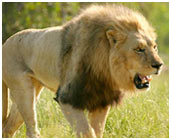Lion is a member of the cat family and is known as the ‘King of the Jungle’. To help you know the animal better, we have given some interesting facts and amazing information on lions here.
Facts About Lion
Lion is a magnificent animal, belonging to the cat family, which has been associated with power, strength, courage and royalty, since ages. Infact, the animal has been adopted as a symbol on royal family crests, coats of arms and national flags of various countries. One of the biggest predators in the wild, the animal is found mainly in Sub-Saharan Africa and Asia. Lions are also amongst the most endangered species, owing to poaching, degradation of environment and high mortality amongst the cubs. In the following lines, we have provided various interesting facts and some amazing information on lions. 

Facts about Lion
Binomial Name: Panthera leo
Kingdom: Animalia
Phylum: Chordata
Class: Mammalia
Order: Carnivora
Family: Felidae
Genus: Panthera
Species: P. leo
Subspecies: Eight
Length (male): 9 feet (2.7 m) (including tail)
Weight (male): 157 to 180 kg (350 to 400 lbs)
Height (male): 36 inches (90 cm)
Length (female): 8 feet (2.4 m) (including tail)
Weight (female): 112.5 to 136 kg (250 to 300 lbs)
Height (female): 30 inches (75 cm)
Body Temperature: 38.33 deg C (101 deg. F)
Number of Teeth: 30
Age: Around 12 years (wild), 20 years (captivity)
Oldest Lion: Nero (29 years, in West German zoo)
Natural Habitat: Savannas, grasslands, dense bush and woodlands, in Sub-Saharan Africa and Asia
Diet: Carnivorous
Maximum Speed: 48 km/hr over 46 m (30 mph over 50 yards)
Age of Maturity: 2 to 3 years
Gestation Period: 105-115 days
Number of Offspring: 2 to 4
Interesting and Amazing Information on Lions
- The roar of a male lion can be heard from a distance of, as much as, five miles.
- Lions usually live in groups, known as ‘Prides’. However, many males and few females lead a nomadic life also.
- There can be up to 40 members in a pride, with over half of them being cubs and young adults.
- The number of males in a pride can vary from just one to as many as seven.
- The largest lion till date was almost 11 feet long and weighed nearly 700 pounds.
- Lions do not eat an entire kill in most of the cases. Other predators, like hyenas and vultures, have been known to finish the kill of a lion.
- The male lions of a group hardly hunt. The lionesses are the ones who hunt and bring the food for the entire pride.
- Even though lionesses make the hunt, they eat the prey only after the males have had their full. The cubs eat after the lionesses.
- The lionesses who do not take part in the hunt ‘baby-sit’ the cubs.
- The eyesight of a lion is five times better than that of a human. It can even hear a prey from a distance of one mile.
- The sense of smell of a lion is so sharp that it can not only tell if prey is nearby, but also ascertain how long ago it was in the area.
- After eating, a thirsty lion may drink for as long as 20 minutes.
- In the ancient times, many communities though lions to be magical creatures and worshipped them as ‘Gods’.
- Lionesses usually stay with the pride throughout their life. However, young lions are driven out.
- Lions mark their territories either through scent deposits or by scratching marks on the trees.
- Lion is the only member of the cat family to have a tassel at the tip of the tail.
- Lions as well as lionesses rub each other in greeting.


See also
More from iloveindia.com
- Home Remedies | Ayurveda | Vastu | Yoga | Feng Shui | Tattoos | Fitness | Garden | Nutrition | Parenting | Bikes | Cars | Baby Care | Indian Weddings | Festivals | Party ideas | Horoscope 2015 | Pets | Finance | Figures of Speech | Hotels in India : Delhi | Hyderabad | Chennai | Mumbai | Kolkata | Bangalore | Ahmedabad | Jaipur
- Contact Us Careers Disclaimer Privacy Policy Advertise With Us Lifestyle Sitemap Copyright iloveindia.com. All Rights Reserved.




